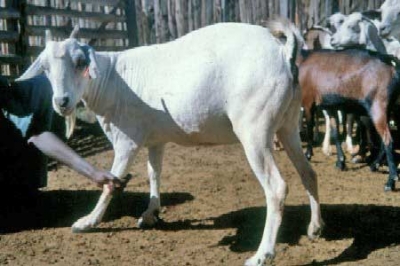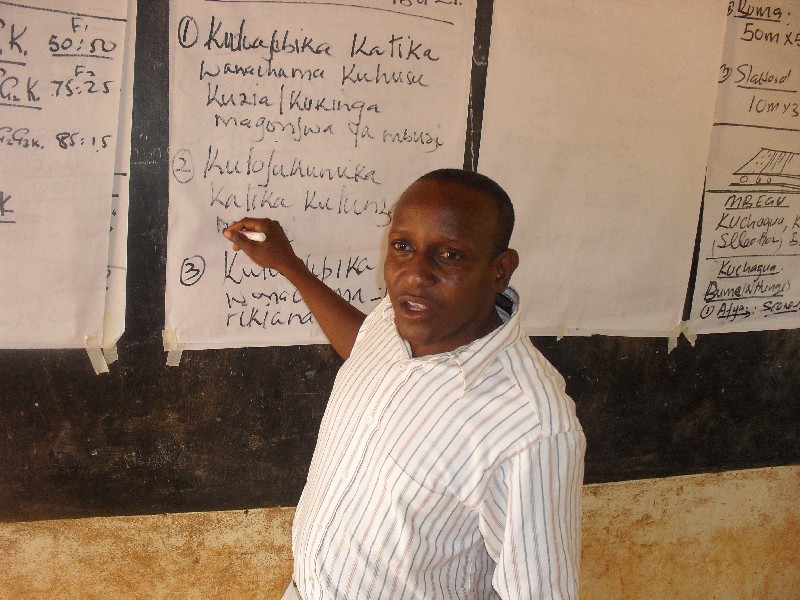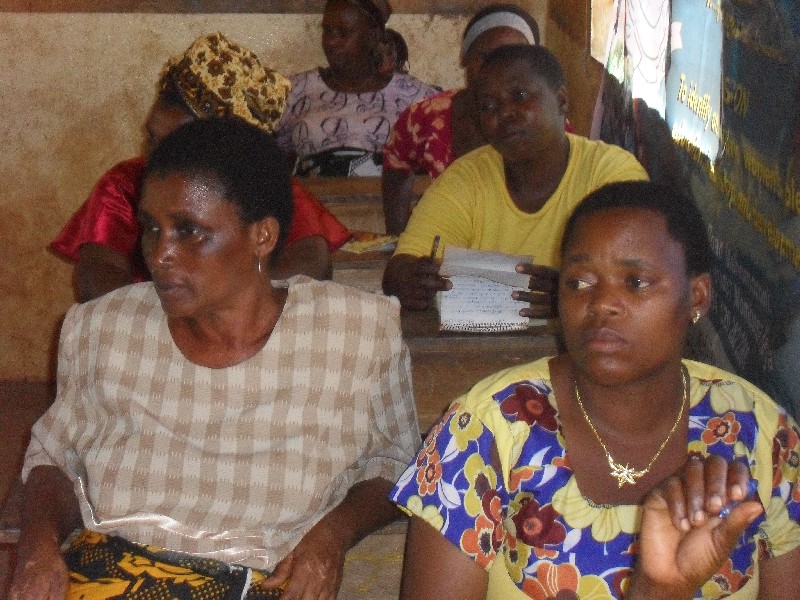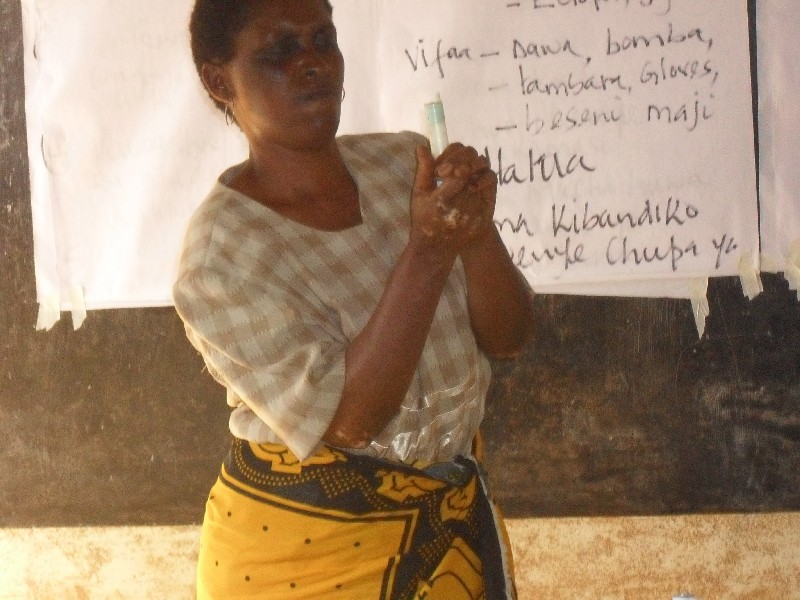Goat Women In Development.
Report for Training on Goat rearing in Ganze Vitengeni

Galla Goat.
Held at Vitengeni Primary School on 15th January 2011.
Why Ganze
Ganze Constituency is in Kilifi County, the place gets very remote and dry during the draught seasons . The Kenya poverty report of 2008 ranks poverty level in Genze at 84% that makes it one of the poorest constituency in Kenya having been marginalized since independence in 1963.
The rampant prevalent forms of sexual violence in Ganze such as forced marriage, forced prostitution, defilement rape ,sodomy and Incest are violence which that still control the community`s daily lives in Ganze thus hindering young girls from attending school. It is also one of the constituencies that have seen change from the free primary education as the area member of parliament puts it that 98 per cent of children of school going age now attending classes in the constituency, possibly the highest for the area since independence . Hon Baya says that he is working to fight poverty in the constituency by investing in children’s education.
Introduction
The forum that brught together two separate women groups together as benificiaries was called to order by the area councilor Mr. Teddy Mwambire then Agnes Fondo Team leader of the group moderated the introduction part.
Welcoming Remarks
Betty Sharon , CWID`s Programmes Director , welcomed everyone to the forum and later highlighted the objectives of the forum and encouraged the women in vitengeni to participate in the program. She later gave the history and background information of Coast Women In Development and their key programs. The vitengeni project is a program called women economical empowerment that CWID`s has been carrying out with the group wrapping microcredit and business education but now has to be taken to another level which will support women in Vitengeni to achieve the Millinium development goal 1 of Eradicate Extreme Poverty and Hunger.
The aim of the goat project is to promote the living standards of women in Vitengeni. Ms Sharon said that it is a pilot project that when succeeds then it will spread to other parts of the country .Tom who is a field officer of CWID emphasized on the project and encouraged women to participate actively in the program. Mohamed Hamisi urged women to grab the rare opportunity that will make them become more responsible ,independent and participate on the elective posts (Affirmative Action) since the goats will be distributed to individuals and not groups .
Facilitators :
1. Michael Mwasaro Livestock Production Extension Officer - Ministry of Livestock Kilifi. 2. Clarckson Chiro Livestock Officer - Ministry of Livestock Kilifi
Topics covered
-
Importance of keeping livestock
-
Selection of breeding
-
Routine
-
Goat breeding
After covering the above topics women were taken to task , they were asked to give a reason why they would want to start goat rearing project, and below was the responses.
-
Money
-
For pride
-
Getting manure
-
Power
Basic procedures of goat rearing
Before starting the project one has to analyze the environment and see if it is favorable for the type of animals to be kept. Types of reared goats in Kenya.
-
Small east African the ordinary type
-
Galla Somali/Borana type
-
Gala and Small East African combination of the two
The East African type was described as that which can give between 22kgs to 40kgs of meat when slaughtered While the Small East African type that is found to do better in the Northern Part of Kenya fetches between 50kg to 60 kg to and Galla can fetch up to 70kgs. The environment of North Eastern is more dry than Ganze, hence it is more appropriate to keep the east African type in ganze as the environment is much more favorable .
Essential requirements.
Structure : importance of having a structure for the goats is to have a good place to be safe from rain, pests and sun, and easy to handle then in a confined environment, to have a clean environment and last safety and security
Types of goat structures
Boma type: This type needs to have a roof, shade, door rifts (fitto) and a ceiling. The place should be clean to avoid the goats to have foot rot and its measurements are; Boma size and measurements 50*50 300
Raised Slated and Type
Slated type of structure size and its measurements are;-
10 metre length X 3 Meters that’s give 30 Meters Circumference

Mr Mwasaro elucidating points on essential requirements for goat keeping.
Seedling.
This refers the steps needed to find a healthy and productive Goat, the steps are Selection ,breeding and culling
Selection
This is the process of selecting the type of goat for the project. The factors to consider in selecting a meat goat.
-
The goat should be health
-
The protruding ribs is sign of unhealthy .
-
Proportional mouth
-
Testacles are a factor to consider. Should be Small and strong
-
Legs are also a factor. Both front and back legs should be strong
Characteristics of male goat.
White in cooler and skin is greyish, the one who is arrogant and like eating
Female type: teats should be smooth and strong. Do not select the one with long teats.
Breeding.
Factors to consider on breeding, a farmer should have female and male goat. The he goat should reach 15months and female is 18monthsand not less the said months.
When the she goat is on heat should immediately be taken to male goat for them to mate.
Gestation period is 147 days to 155 days , heat period for the female goat is 24hrs to 36hrs.heat intervals is 21days periods. The farmer should be very keen on this process.
Signs to show when a goat is on heat, the she goat start producing some signs to show her time is ready.
-
Unusual noise
-
Jumping into others and yowl
-
Produce semen on the female organs. The farmer should be carefully on observing the signs
-
Female organs turn into reddish in color
-
Loose appetite
-
Reduce production of milk.
Heat intervals.
When observing the sign of heat from the female goats, the farmer needs to count hours from zero to 30.also the farmer should have taming from 12hrs to 18hr
Women were also taken through cross breading of the goats session as the following the procedure as follows
G1*K1 G1KI 50:50 cross breeding
G1K1 *G2 G1G2K1 75:25 back breeding
G1g2k1g3 g1g2g3k 85:L15

Participants in the training following the process
Challenges
The facilitator said some of the groups they end up fall down because they lack knowledge of goat rearing project thus the goats end up dying of the mentioned diseases , also lack of cooperation with the relevant ministry , ignorance in using the harmful medicine.
Diseases like anaplasmosisi, goat sickness, pneumonia, diahorea, typanosomiasis and mitese are very dangerous to livestock moreover may endanger the program of goat rearing There are medications which that can assist to eradicate these kind of infection , the diseases can as well be prevented through the following steps.
-
Clean environment: the environment should be clean for the livestock to have a clean and healthy environment.
-
Enough and healthy food for the goat
-
Separation : this is the process of separating the sick goats from the health ones
-
Spraying the goats at the right time they will be out of pest infection
Signs and Symptoms of Anaplasmosis
Caused by a virus called anaplasma, spread by insect (kupe) like to stay on the feet ,eyes, ears, testes, and thighs, when the insect attack the livestock it causes;-
-
Causes fever
-
Yellow color appears in the eyes
-
Stool contains semen’s and hard fleeces
-
Goats bladder is enlarged and becomes complicated
-
Normally the goat dies instantly
-
Liver turns yellowish
Prevention Spray the goats weekly Pneumonia
This disease is caused by a virus called ccpp (mycloplasma) is a disease which is spread from one goat to another. Signs and symptoms
Pressure (breathing continuously) Fever Mucus is always yellow Enlarged stomach Coughing
Prevention of mycloplasm
Separation: separation of the sick goat from the healthy ones. Pneumonia vaccination Slaughter all the sick goats and burry all the levers, for the reason that they contains the disease.
Chronic infection.
Caused by insects called mites
Signs Shedding of fur Scratching on the back Fungal infection called damatomosis Loss of weight Continuous breathing
Prevention Deep the goats using insect sides twice a week Separation of the sick goats with the health ones.
Cleaning of the animals Equipments: Triatix Spray ectoper, bytical
Medicine , pump clean cloth ,gloves, masks, basin and water
Steps to follow
-Read and understand the prescription on the bottle
Mix the medicine with water according to the measurements.
Get the right measurement of medicine on the syringe or any measured container of medicine eg 20ltrs of water to 40ml of medicine or 10ltrs of water to 20ml of medicine
You need to identify the parts which ticks are likely to hide in, that is eyes, teats, armpits, thighs, private parts and feet.
Start from behind passing the tail armpits to the front side. this exercise is done twice a week. if you starts from the front side the goats are very sensitive around their ears and eyes, so it is advisable to start the exercise from behind.
Dawa norotraz
Process of deep washing.
The exercise should be done in the morning in addition to making sure the goats have drunk enough water so that they don’t drink the medication .
Nagana disease
Nagana is a disease caused by an insect called tsetse fly.
Signs of nagana disease
-
Lose of weight
-
The fur stand still
-
Stool contains blood spots in it
-
Swelling of throught as is suffering from tonsilities
-
Causs sleeping sickness called trypenasoms

Above. Zawadi Ndzila domonstrating to participants how to mix
the medicine for cleaning goats.
Prevention
-
Use the right animals medicine
-
Wash the animals once a week
Cure
The farmer should seek medical attention from the veterinary doctor.
Conclusion
Betty took over after the facilitator then apologized for the time frame and suggested that the group do Way Forward that will fit their schedule.
Way forward
Date Activity Who Where
22/012010
Election of
officials
Group
D.O`s
office
Jan to
Feb
Putting up of structures Group
Group’s Residence
Jan to March Engage an
advisor
CWID
Vitengen
Feb to March Follow up
Training
CWID
Vitengeni.
Team Leader Janet Fondo
Appreciation.
Our earnest gratitude goes to Wyndham International the institution that is partnering with CWID to realize the success of the project, without them the long awaited project may not have seen the light.
Compiled
by :
Mohamed Hamisi
Consultant,
Coast Women In Development